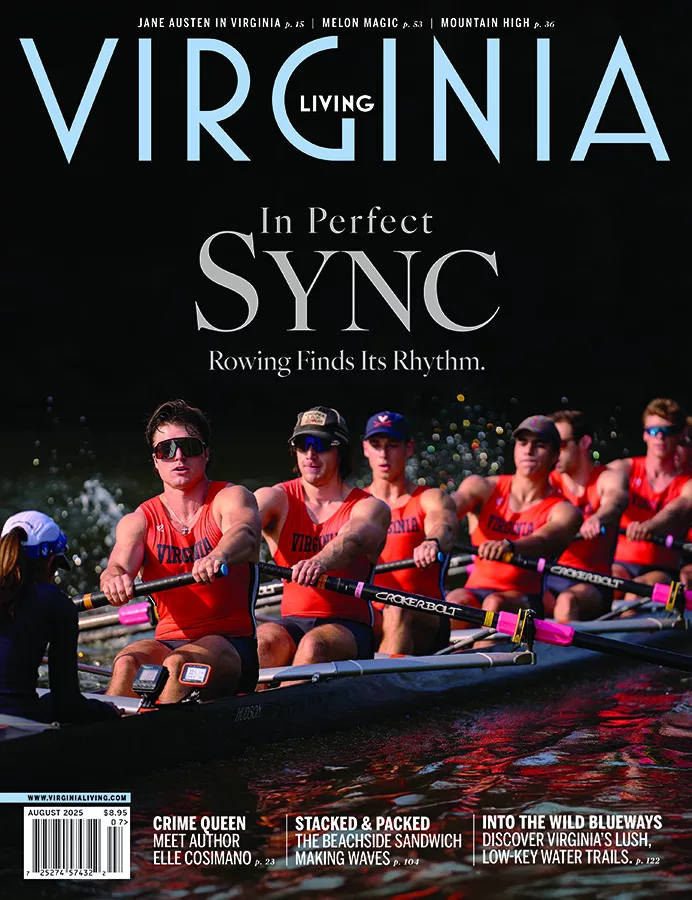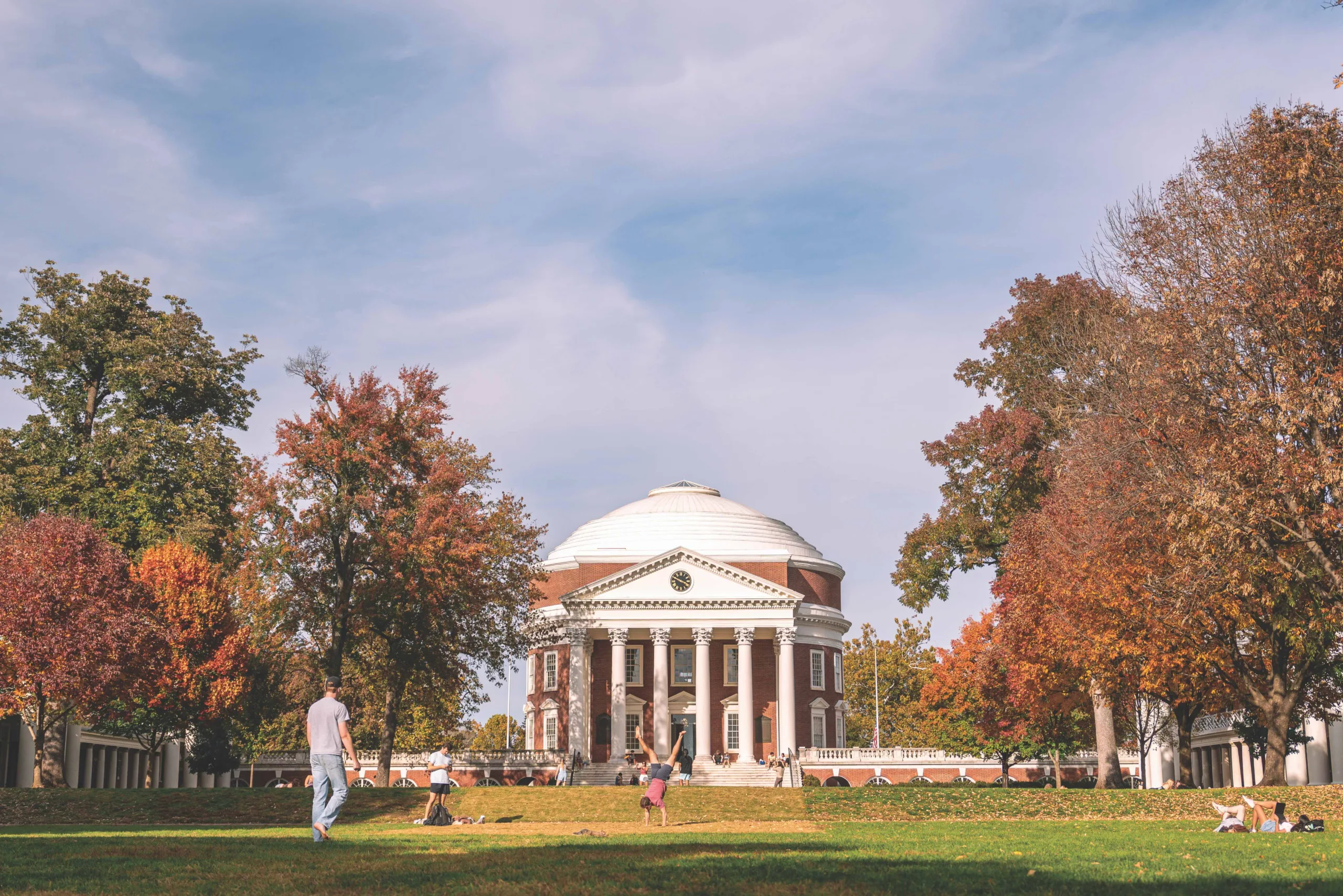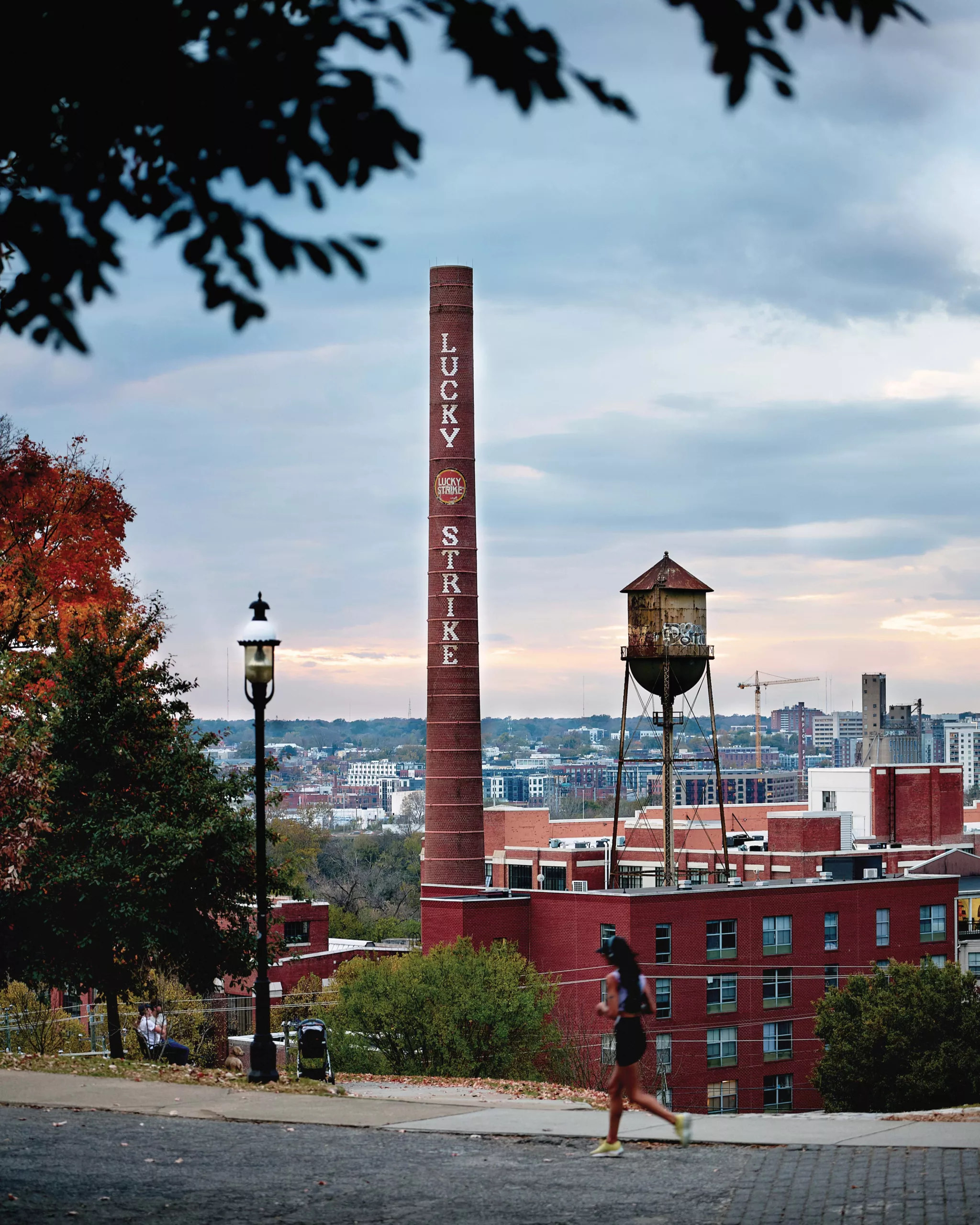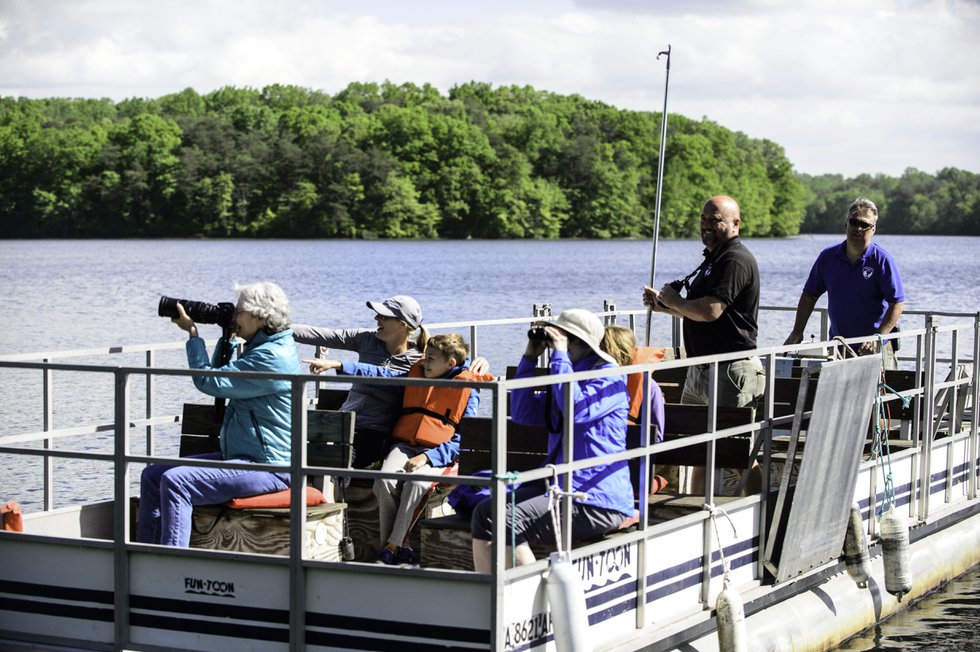Its environmental issues mostly behind it, Front Royal is now hustling to unveil its charms. It’s got a diversified economy, historic downtown, emerging nature conservancy—and one of the most enviable locations in Virginia.

Kelly Walker, a co-owner of Delilah’s gift shop.

A set of cutlery at Delilah’s.

One of Front Royal’s chief assets is the Shenandoah River, seen here from the end of Luray Avenue.

Don LaFever, an employee at the Visitor Center.

A prime rib sandwich at the County Seat Pub and Eatery.

Barbara Dunmire, owner of Ole Timers antique shop.

The Main Street Mill.
Nearly all cities have an identity of sorts, built over time, and it’s not terribly easy to change it. Consider Front Royal. Situated at the foot of Massanutten Mountain and the entrance to Skyline Drive, the town has always had an enviable location. Visitors have long come to Warren County to hike the mountains, visit nearby wineries and enjoy the Shenandoah River. In 1999, the Virginia General Assembly designated Front Royal as the state’s Canoe Capital.
But the charms of Front Royal itself have never quite matched those of its beautiful surroundings. (Whose could?) For decades it was a classic factory town—and, more specifically, a one-company town. Starting in 1940, American Viscose Corporation operated a major rayon and polyester plant in Front Royal for almost 50 years. The physical footprint of the factory occupied 10 percent of the town. The plant was a good thing for a while: Some 2,500 people worked there during its peak years, when it was the largest producer of rayon in the world. It was also the largest employer in Warren County. American Viscose was a significant contributor to the U.S. effort in World War II—its fibers were stitched in parachutes and roped into the inner cording of tires on aircraft and jeeps. Later, under the ownership of Avtex Fibers, the factory produced components for NASA’s space shuttle rocket nozzles.
But over time, serious problems emerged. For one thing, on occasion the production process produced a sulfurous stench that hung over Front Royal. Worse, heavy-metal sludge and other toxic byproducts from the plant leached through fissures in the limestone bedrock and into the Shenandoah River. PCBs made fish in the river inedible. The plant became an environmental disaster—so much so that, in 1986, the federal government, through its Superfund program, took control of the 430-acre Avtex site. Three years later, Avtex declared bankruptcy and closed the factory.
The plant closing brought short-term pain—lost jobs—but over the long term its disappearance will be a very good thing for Front Royal and the 14,500 people who live there (surrounding Warren County has a population of about 35,000). Why? Because, say town officials, Front Royal can now redefine itself, free from the stigma of pollution; and, indeed, the town is busy creating a new identity. The Economic Development Authority, working with the consulting group SRI International, has developed a master plan for the revitalization of the area, comprising several initiatives—among them, boosting the number of small business startups, attracting more outside investment, and “branding” the town more effectively.
The biggest priority is redeveloping the 430-acre Avtex site, now named Royal Phoenix. The federal government and FMC, a prior owner of the rayon plant, have spent years cleaning up the land. Miles of piping, truckloads of building materials and tons of earth have been moved to secure landfills. Toxic lagoons were capped and seeded with tall grasses and shrubs. The cleanup will take years longer to complete, but town officials are optimistic about the recovery process. Half the property is destined to become a nature conservancy, with a hiking and biking trail system, and the plan is to turn the other half into a business park.
Wayside Theatre, based in nearby Middletown, is leading the way. It has taken over about half of the only remaining original building on site, the Art Deco brick structure that originally housed executive offices for the plant. It is the theater’s temporary home while its home stage is being renovated. Artistic Director Warner Crocker sees the 151-seat theater as the vanguard of coming attractions at Royal Phoenix, though it’s not clear if Wayside will remain at the site after its home-stage renovation is complete.
“The mark of a community’s character is how it handles adversity,” says Mayor Jim Eastham, a Front Royal native. “The town could have thrown in the towel [after the Avtex debacle], but instead it rolled up its sleeves. It’s taken some time to develop a vision, but the community would not accept being the home of a Superfund site. Our mission has been to turn this liability into an asset—make the site a place to come to and not avoid.”
Sharon Baroncelli, president of the Front Royal/Warren County Chamber of Commerce, came to Front Royal recently. She and her husband bought a country farmhouse and moved the family down from Fairfax. “It’s a comfortable place to live,” she says. “There is no congestion and no crime, and it’s a good place to raise your kids.”
She says that the town is in a “transition stage”—one she characterizes as “the old meeting the new.” The “old” can be seen in Front Royal’s historic downtown. Main Street has a wide variety of inviting antique and specialty shops. The funky Vintage Swank (now being renovated) is a two-story emporium stocking more than 15,000 items from the 1920s to the 1970s—clothing, furniture, housewares. Proprietors Mitch and Amy Hazam have preserved three-way mirrors and other interior fixtures from the store’s founding in the 1950s as the Boston Shop, a fine clothing store for women. Architectural Old House Parts is a warehouse full of salvage material; Bobbin Along Quilts stocks 1,000 bolts of fabric; Stokes General Store, originally opened as a World War II army surplus shop, is now a “working man’s store.” Ole Timers Antiques has another shop on its premises, The Whistle Shop, that caters to model train enthusiasts. Delilah’s is a new gift shop featuring original art, hand-made jewelry and crafts.
The “new” is visible on Route 522, a few miles outside of town. There, Lowe’s, Target, Staples, Cracker Barrel and TGI Friday’s (Front Royal’s first chain restaurant) have all opened in the last five months. There are also two new shopping centers. Farther out, one can see why Front Royal’s jobless rate is under 3 percent (down from 17 percent after the plant closed): There is a DuPont automotive paint plant, a distribution center for Sysco, a Japanese automotive parts plant (owned by Toray), an Interbake facility (which makes wafers for ice cream sandwiches) and the Virginia inland port—a growing intermodal container-transfer facility for products destined to be trucked to the northeast. “We don’t rely on one industry anymore,” says Eastham.
According to the mayor, tens of millions of dollars have been invested in town improvements in recent years. There are two new high school facilities, and downtown Front Royal has been spruced up dramatically. The old train station was converted into a visitor’s center; a parking lot was transformed into the Village Commons, a park where the Blue Ridge Arts Council puts on various concerts and community events. One of them is the annual Wine and Craft Festival, held each year in May.
Where to stay? There are several quirky 1950s-style motor lodges in the area, and EDA deputy director Jorie Martin says there are a few “delightful” B&Bs for visitors. They include Lackawanna, a historic Italianate-style house near the river; Tanglewood, a 1905 Colonial on a hill overlooking the town; and Woodward House—check out its comfortable rockers on the long veranda (if weather allows).
Killahevlin, an Edwardian mansion built in 1905, was originally the home of William Carson, an early 20th-century politician and major force behind the construction of Skyline Drive. Today it’s a charming inn with four guest rooms and two suites, all with fireplaces and most with private sun porches. An on-site Irish pub has Harp Ale on tap. Innkeepers Tom and Kathy Conkey put sherry and homemade cookies in each room every day, to keep guests fortified. And every morning, they offer breakfasts featuring homemade scones, fruit dishes, pancakes and a version of eggs Benedict that starts with a savory Parmesan waffle instead of the typical English muffin.
For dining, the Conkeys have two suggestions: Apartment 2G Restaurant and Soul Mountain Café. Occupying the second floor of J’s Gourmet shop (where a bar named Element can also be found), Apartment 2G features nouvelle dining. Tapas are served on Tuesday and Wednesday nights, and Friday and Saturday nights feature a five-course, prix fixe menu. Soul Mountain is more casual, offering a fusion of Southern, Cajun and Caribbean cuisine.
Those who like to hang with the locals can visit the Main Street Mill, a restaurant and tavern, or the County Seat Pub. The Knotty Pine is a local landmark that’s been serving food for some 60 years. Come in any morning for breakfast. Tillie Williams has been behind the stove for 23 years. There’s a bar in the back that’s a favorite with bikers and good ole’ boys. “Half the folks in town would never come here, and the other half would never go anywhere else,” says Roger Speck, the Knotty Pine manager.
Of course, every Virginia town worth touring has some Civil War history. In Front Royal, visitors will find Belle Boyd Cottage, which during the war was a hotel operated by the famed spy’s aunt and uncle. Belle used the cottage as her safe house while she spied on occupying Union troops. These days, natch, it’s a museum.
The Gray Ghost himself is represented at Prospect Hill Cemetery, where a monument notes the execution of seven of John Singleton Mosby’s Rangers in September 1864. After the war, the Ladies’ Warren Memorial Association was chartered to collect Confederate dead from Warren County, to be buried in a circular lot at the cemetery’s highest point. Known as Soldiers Circle, it contains the remains of 276 soldiers, representing every state in the Confederacy. Of these, 90 were identified and 186 were buried as unknowns.
Down by the river, the new Front Royal is slowly emerging. Thirty-five acres of the former Avtex site has been reclaimed and developed into a soccer complex. An additional 56 acres will be ready for development by the end of 2008. On the 240 acres that’s growing into a nature conservancy, scientists from the Smithsonian Institute have already documented the return of amphibians, butterflies and at least 66 separate species of birds.
John Torrance knows the terrain—and the work that’s gone into reclaiming it. Site manager for FMC, he can tick off the exact amounts of coal, oil and other material that have been trucked from the site for disposal and recycling. He points to a leveled area that was once a 23-acre mountain of flyash, the byproduct of coal burned to run the rayon plant. Then he points to what was once called Sulfate Basin Number Five, a retention pond by the river. What once bubbled with factory refuse and occasionally turned purple with algae bloom now thrives with catfish and sunfish. A blue heron fishes among reeds at its edge, then takes flight as Torrance approaches. “That,” he says, “is the best fishing hole in Front Royal.”









